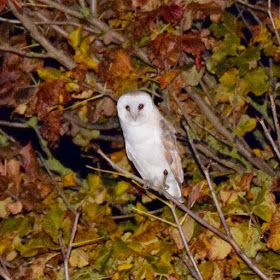Its a while since I last blogged but when I did, I queried whether the autumn owlets would hang around this winter having fledged so early. I am pleased to report that they have. The adults have tolerated these young adults which is a great help to the youngsters who can stay on familiar territory and help themselves to food during the harshest of weathers.
It is still possible to see the two distinct broods across the farm. The beehive family are roosting in the combine shed with our original parent birds. They fly over to the house or wait in the open sheds to the east of the feeding platforms. I see them through the shed lights or pick them up in my torch beam waiting in the trees in the field. They take food from the shed roof and fly back in the direction of the natal nest site to eat their cache. The experienced female usually flies in first and I know the youngsters are hers as they sometimes chase after her for the food she has taken even though there is plenty left for them. These birds are exceptionally brave and wait close to me but when I try to take some, my photos are disappointing because the roof is simply too high to get a good shot of them. I remember in 2018 when I fed them close to the house and I would have to flail the torch around wildly to keep them at bay as I ran to get positioned with my camera. Those were some of my best action shots but now I am content to know they are fed and have shelter.
The west nest box owlets still favour the straw and the nest boxes secured under the dutch barn eaves. I see these owls high in the rooftops especially on windy evenings. They also wait in the trees to the west that are adjacent to the box they were reared in. They dive and swoop close to the straw but also join the other owls and take food from the shed roof without any animosity. I've also watched one bird that checks out a feeding station at the far end of the dutch barn that I haven't used in years. I am unsure whether it simply recognises it as similar to the others or whether it remembers food being left there. This was the original platform from 2012 and I would love to know if this bird actually fed from it. If so it is a good few years old and another owl to rival our original female in longevity.
We have had a substantial amount of hay moved over the past couple of weeks. I know the owls are roosting between the warm bales because there are holes that have been smoothed around the edges and are a perfect owl shape and size. I had been watching an especially low bolthole and felt sure it was used by the little owls, but when the bales were moved I was surprised to find barn owl feathers and pellets left behind. Max thinks this is all terrific and wastes no time eating any pellets he gets to before me!!
Early one morning this week, a customer came for a number of bales and a very light male flew from its hay roost and over the field to a nearby ash tree. It wasn't happy and fairly swiftly flew back to the nest box but there was too much noise and it lost its nerve. It headed back to the tree accompanied by daddy kestrel who was still waiting to fly in for breakfast and was none too pleased to see an owl out. More worryingly, we now have a buzzard waiting in the trees each morning. I'm not sure if it is hoping for food but I would rather not have one of my naive young barn owls out at the same time. I left the yard with my nerves on edge but was followed soon after by the machinery leaving the farm. The yard was quiet once more and the owl could find another cosy nook until dusk fell once more.
In the past few weeks the owls have contended with their first storm in the form of Storm Bert and they have experienced snow and more frosty nights than we had last winter entirely. We've had rainy nights in succession which is never welcome but also some mild and still conditions in which they can learn to hunt for themselves. Twice I have driven along the top bank and seen an owl hunting the grass verges. I was also lucky enough to get an afternoon viewing of a very light male bird a couple of miles from ours. These birds could easily be some of our youngsters. They could also be potential mates for ours as they begin to disperse later in the winter. I have however, a few weeks more to enjoy watching these special birds and I mean to enjoy it to the full.













.jpg)







































